![Jerry Hammes.com [Logo]](../../../images/logo.jpg)
|

|
Hammes Information Commons Dedicated to Dorene - 2007 to Present
[Back to topic list] [Back to Indiana University Topic]   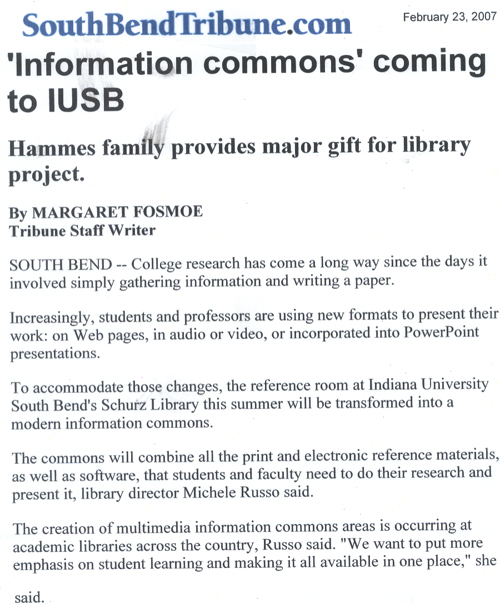    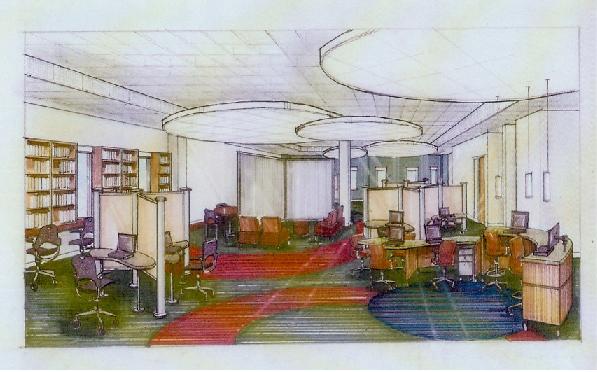  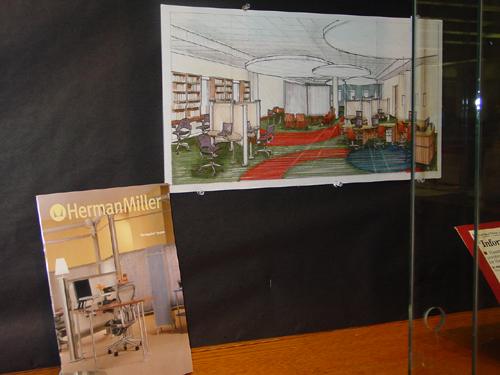    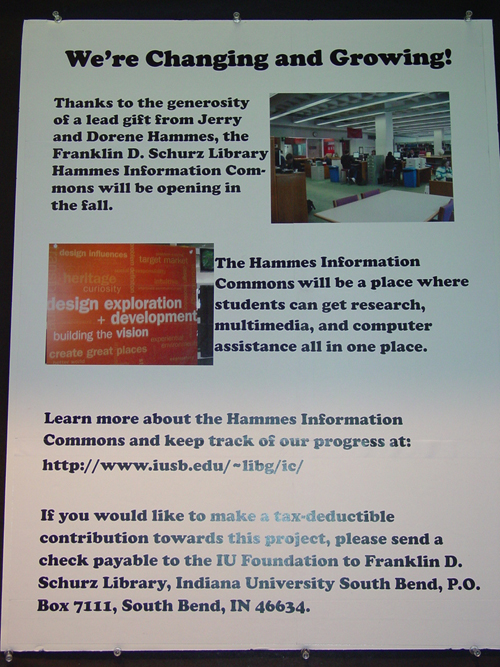 IUSB's $350,000 center provides new approach to study  Tribune Photos/SANTIAGO FLORES Rusty Heckaman works on a computer in the Hammes Information Commons at Indiana University South Bend's Schurz Library.  Indiana University South Bend students work in the new Hammes Information Commons on the main floor of the Schurz Library.  Tribune Photo/SANTIAGO FLORES Floyd Dixon and Linda Dawson talk as they work on assignments in the Hammes Information Commons at Indiana University South Bends Schurz Library. MARGARET FOSMOE Tribune Staff Writer SOUTH BEND -- College homework these days often requires a team approach. Professors increasingly are asking students to work in groups, create PowerPoint presentations, and add audio and visual elements to their class projects. The goal is to mirror the modern workplace, as more companies create teams to spur creativity and productivity. Indiana University South Bend students this fall have a new place to go to develop those skills. The Hammes Information Commons recently opened in the Schurz Library. The casual modern gathering spot -- with contemporary office furniture, colorful carpeting and indirect lighting -- was created in the library's former first-floor reference area. College students of a few years ago wouldn't recognize the place. There still are shelves with reference volumes. But most of the space is devoted to more than 50 personal computers for electronic research, writing papers, adding audio and video, and team projects. Students have settled comfortably in the new space. Many wear headphones as they go about their studies. "It's a space that's very inviting," library director Michele Russo said. The commons has drawn crowds of users since the day it opened. Students Cathryn Frazier and Gabriel Burgin recently spent a morning in the commons working together on a business class assignment to design a personal computer on paper, complete with pictures. The extra-wide computer monitor made it easy for them both to see the screen. Professors expect lots of multi-media elements, and working in teams is encouraged, said Frazier, an IUSB freshman from Granger. "They are trying to prepare us for the working world," she said. Employees are very helpful in teaching students how to use the equipment to add those elements, said Burgin, a Purdue University College of Technology student from South Bend. Students today are told don't separate print, electronic and video resources, but rather rely on all those forms regularly, Russo said. Library multi-media specialists are available to help students who are new to some forms of research or production. The library cut back on its print reference collection, because most older indexes are available online. About 150 electronic databases provide access to 30,000 electronic journals. The $350,000, 4,377-square-foot facility was named in honor of Jerry and Dorene Hammes of South Bend, who provided a major financial contribution for the project. The Hammes family dedicated the gift to Dorene Hammes. Four computers in the commons are available to the general public, although students receive priority. Multimedia information commons areas are popping up in academic libraries across the country. The Bloomington campus developed IU's first information commons, which was so successful that the main campus has added a second commons.        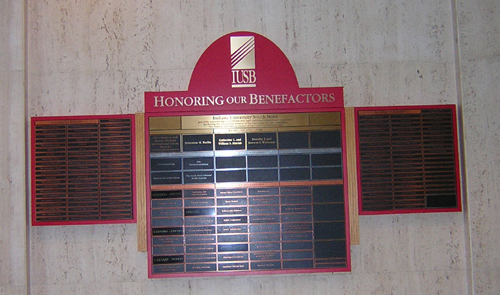      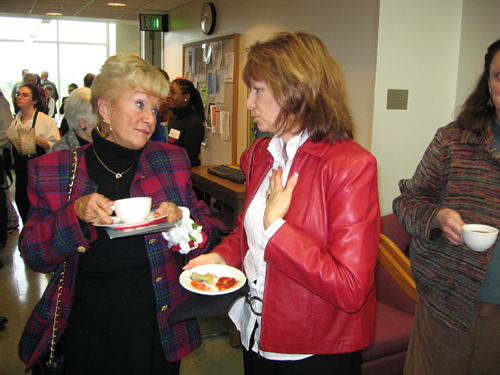                       Talking in the Library Hammes Information Commons lets students work like they should Go ahead and talk when you visit the Hammes Information Commons in the Franklin D. Schurz Library. No one will shush you. 'This is not a quiet room,' says Michele Russo, dean of Library Services at IU South Bend. 'This is a vibrant room. The way students work, and the way faculty members want them to work, is together in groups.' The Commons is the place for that. The Commons resulted from a renovation of the reference room. Leading donors were Dorene and Jerry Hammes, active members of the South Bend community, who saw the need for a real library improvement. What do you mean by real? Russo says that IUSB's library, like many others, has concentrated in recent years on the virtual library and online resources. 'But as a real place, the library is still an important destination for our students to get help,' she says. 'This kind of renovation is a way to keep them coming to us.' And it is working. Russo says she took an informal survey of students during spring semester. Results show the majority who visited the library regard the Commons as their favorite study spot. Inclusive Tech The Commons features computer workstations. Moreover, it features help in the form of the reference librarian as well as IT and media consultants. And the Commons is accessible to all. It includes an adaptive technology room with workstations that elevate or lower for students confined to wheelchairs. Computers there also feature software that allows students to speak commands rather than type, or have documents or Web pages read to them. 'It really is an exciting place,' Russo insists. 'The name is even based on places like the Boston Commons where people go to exchange ideas. Most hours of the day, every seat is filled.' With students who are talking. 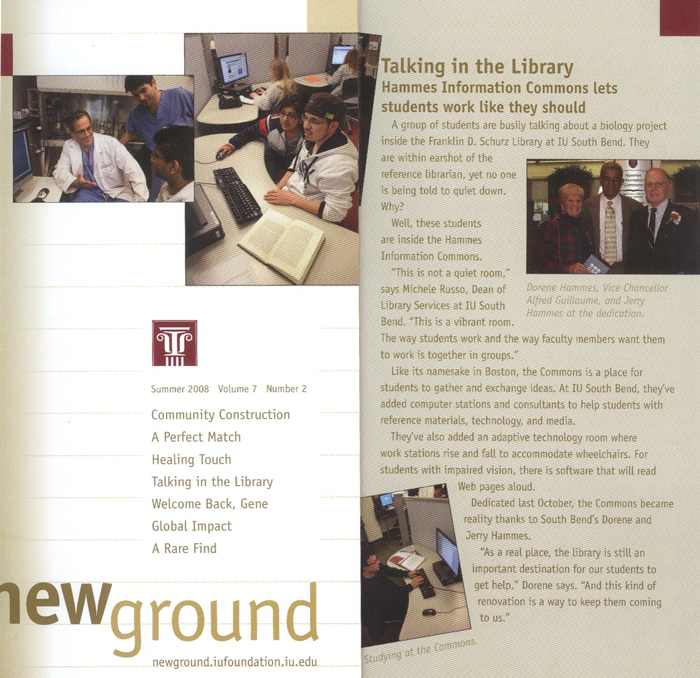 American Library Association's TechSource, an online newsletter The Space had to say "Wow!" - The Hammes Information Commons at IUSB Submitted by Michael Stephens on September 3, 2008 - 9:52am.  I recently had the chance to visit with long-time colleague and friend Michele Russo, Dean of Library Services at the Franklin D. Schurz Library at Indiana University South Bend. We've known each other awhile--she taught reference classes while I was in the MLS program. While at SJCPL, Michele and I would have lunch occasionally and catch up on our library-related conversations. I was glad that she and I reconnected this summer, because a couple of years ago she had told me about her plans for bringing an information commons space to the library. After visiting the spaces at Loyola and Georgia Tech, I was intrigued to see a commons at what I consider to be one of my "hometown" libraries." We had lunch and chatted about the processof designing and reconfiguring the space. She also gave me some background about the project: Indiana University South Bend is a primarily commuter campus offering undergraduate and graduate degrees to approximately 7500 students from north central Indiana and southwestern Michigan. The six-story, 86,000 square foot Schurz Library was built in 1989, just prior to the dawn of the age of the Internet. The reference room was located off the main lobby in an enclosed room with two doors which channeled users either to the right or left of the reference desk. It was designed to house an almost entirely print collection and to provide a quiet, subdued space for individuals to research. Over time, of course, computers were retrofitted into the space to allow access to library databases, but students had to move to the computer lab in another part of the building to use the productivity software to write their papers. As the Library created more of a virtual presence, the 'library as place' was becoming less important to students, particularly as they increasingly valued social learning. This was a situation that we wanted to turn around. After lunch, we toured the space. The reference room I remember was long gone! I was so impressed, I asked Michele if she might tell us about the transformation. Happily, she agreed. MS: I vividly remember working on my weekly reference assignment in 1993, sitting on the floor in the huge row of book stacks with various social science books. Now, those stacks are smaller, with more space for seating, computers and other technologies. What were your goals for transforming the space? MR: Working with Instructional Media Services and Information Technologies, we envisioned making the Library a true teaching-learning-research center by creating an Information Commons where content, technology, and services provided by reference librarians, technology assistants, and multimedia specialists were available to students and faculty in one place. We wanted to create a space where students could work individually or in groups ' at computers or in comfortable seating areas and for this to be a gathering place open to everyone where they could access and create knowledge and where they could their share ideas. We wanted this to become the place that students would choose to spend their unscheduled time. And to do that, we knew that this space had to say Wow! We shared this vision of what would happen in the space with our design firm, Maregatti Interiors (out of Indianapolis) in January 2007 who quickly grasped the concepts that we were describing. They also brought to our attention other important factors that should impact the design. First, they believed it important to respect the vision of the original architect and to recognize that the renovated space would still be an integral part of the rest of the library building which is in a very traditional style. While it could have a much more updated look, the design would have to complement its surroundings. Our designers were also committed to issues of sustainability and kept this in the forefront as they recommended furniture, carpeting, and lighting. Maregatti translated our words into a design that not only met our needs but far exceeded any of our expectations. Anyone walking into the Hammes Information Commons immediately senses the openness and vibrancy of this space and "Wow!" is a word we hear often from people who see the space for the first time. MS: That's what I said when we arrived at the library for the tour after lunch! I could see the attention to making the space inviting and more open. The ceilings actually had light panels that looked like clouds. I advocate for library spaces to be encouraging, comfortable and exciting. You really captured it. What changes did you make?  MR: To send the message that this was a welcoming place, the wall separating the room from the lobby was removed. The stacks were turned 90 degrees which allowed natural light to flow from the windows between the aisles to the center of the room. The new service desk was also designed to send a welcoming message. It allows space for librarians, IT consultants, and multimedia specialists to work at one of two levels. The counter-height level allows service to people as they walk into the Commons, while the lower desk-height permits one to work at eye level with students in a wheelchair or with those who want to be seated as they receive more in-depth assistance. The sense of vibrancy comes, in part, from the use of bright colors and patterns in the carpet. The use of 'clouds' not only provide acoustical treatment and help define space, they also contribute to the Wow! factor. MS: Like other Commons spaces I've visited this year, it seems the almost every aspect of the space and its contents were carefully planned as well as focused on students and their needs. MR: Yes, the area also offers a variety of workspaces to allow for a diversity of learning styles of our students. There is a 'computer bar' with ten workstations and a cafe height area with four computers for students working alone. We use the Herman Miller Resolve system for an additional twenty-eight workstations. This system is accurately described as providing 'open, friendly work spaces' which 'encourage people to connect for interaction and collaboration.' The Resolve system separates each work area with screens which defines a sense of privacy while being located in a very open space. Each work area provides space for individuals or groups to work comfortably. In addition to computer workspace, the Commons also has a variety of large and small tables which allow students to spread out their materials while studying or researching. There is also an abundance of comfortable soft seating. While the feeling of vibrancy is an important aspect of the space, the room also feels warm and inviting. This is accomplished, in part because of the use of a warm blue paint on two walls. The variety of pendant and cloud lighting also add to the warmth. The designers also took special care in planning the Adaptive Technology Room for use by students with disabilities. The color pattern on the carpet continued into that space and appropriate comfortable and attractive seating and workspaces were selected. MS:How has the response to the new space been? What have you observed? MR: We opened the Commons in mid-September 2007 and the positive responses from our students and faculty have been overwhelming. Our gate count and the number of reference questions have increased as has the use of printed reference materials. There is seldom an empty seat anywhere. Students work individually or together in small groups. The room buzzes with energy ' the energy of learners engaged with each other, engaged with cutting edge technology, and engaged with knowledge. We conducted an informal survey in the spring and the results clearly show that this has become the place that students choose to spend their unscheduled time. More than 80% of the respondents said that the Hammes Information Commons was their preferred study spot on campus. More telling is that there is seldom an empty seat anywhere. We receive nothing but positive comments such as these: **The new improvements are wonderful. I love the thought-out variety of workspaces. **Great place to work and do homework. Comfortable, convenient, helpful. **Looks great. Makes me feel welcome. ** Great help; I now have all that I need to get my assignments done in one place. It was gratifying to witness a student showing the Commons to his father and proudly telling him this is the place that he now 'hangs out' between classes. The Commons has also received much attention in the community. Once at a checkout line at a local store, I overheard the young clerk tell her colleague that she would be starting classes at IU South Bend in January. When I mentioned that I worked at the Library, she told me that she had heard that we had a 'really cool new place.' MS: That's exactly the kind of stories we want being told about the library. Thanks for sharing your planning process and ideas for student centered, welcoming soaces, Michele! ______________________________________ About the space: The Hammes Information Commons houses the Schurz Library's 10,000 volume print reference collection, along with nearly 50 workstations to access to the Library's digital collection of over 150 databases and nearly 30,000 electronic journals. There is also productivity software students need to complete their projects. Many of the spaces for workstations are large enough for students to work collaboratively and for faculty to coach them. There are also informal learning spaces to encourage small groups of faculty and students to continue conversations begun in the classroom. The Hammes Information Commons also hosts technology to facilitate production of multimedia. Additionally, there is a large flatbed scanner and a 42" mobile plasma display monitor for use by faculty or large groups anywhere in the Hammes Information Commons. There is also an Adaptive Technology Room with specialized software for students with disabilities. Wireless network connection is available throughout. The Hammes Information Commons is named for the primary benefactors, Jerry and Dorene Hammes. 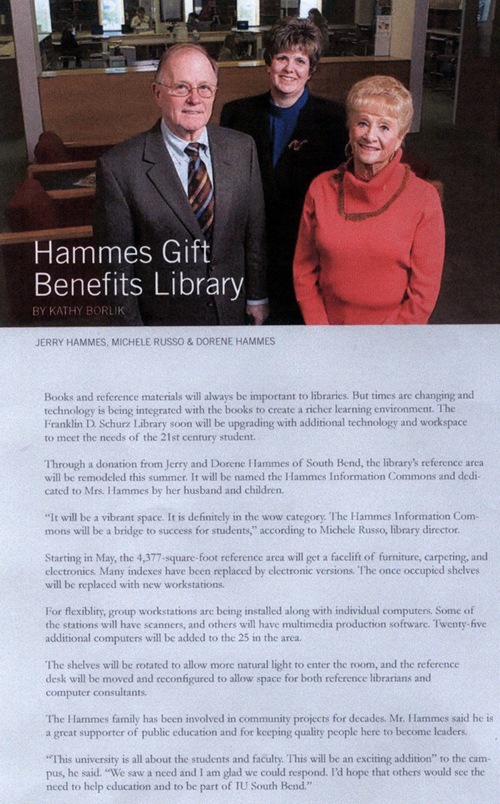       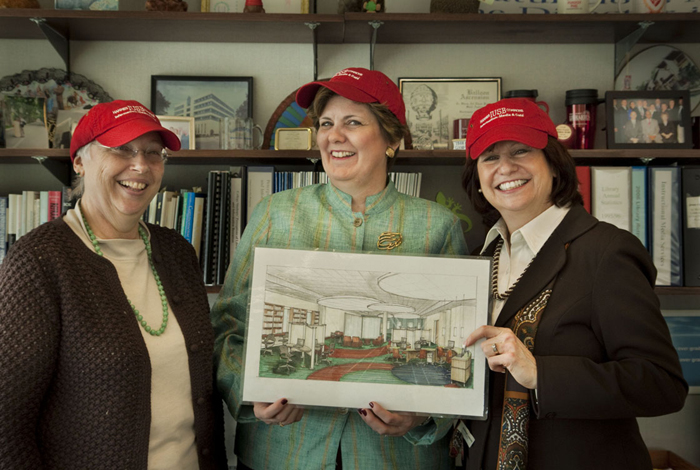 Dina, Michele and Sue. The caps are wonderful. Thanks so much 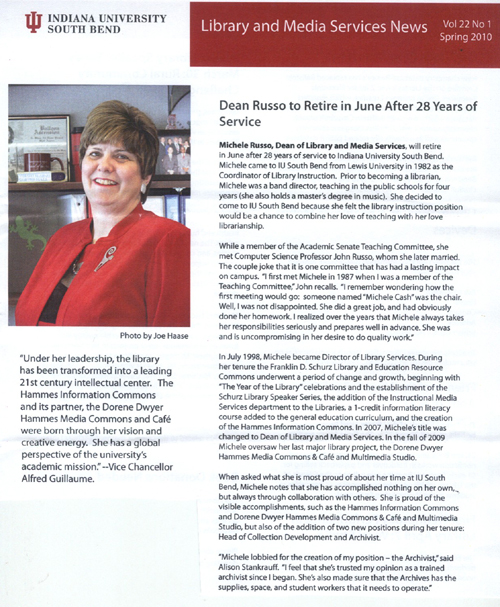 |
 |
 |
 |
 |
 |
 |
 |
 |